-
×InformationNeed Windows 11 help?Check documents on compatibility, FAQs, upgrade information and available fixes.
Windows 11 Support Center. -
-
×InformationNeed Windows 11 help?Check documents on compatibility, FAQs, upgrade information and available fixes.
Windows 11 Support Center. -
- HP Community
- Notebooks
- Notebook Video, Display and Touch
- HP Pavilion Gaming 16 - A00XX not working ELAN TOUCHPAD.

Create an account on the HP Community to personalize your profile and ask a question
08-15-2021 05:17 AM
About a month ago I bought an HP Pavilion Gaming 16 - A00XX laptop with windows 10 (32 bit) operating system installed. After deploying the operating system, most of the drivers were installed automatically, including the drivers responsible for the touchpad. After a while, I noticed that the touchpad was not working at all. Looking at the data in the device manager, I found that the touchpad is configured when the computer is turned on, but it cannot start (hidi2c.inf). Since a virtual machine was installed on my computer to work, I thought that some drivers might conflict with each other, and possibly recently installed operating system updates. Accordingly, I deleted the virtual machine, but this did not give any results. After that, I decided to reinstall the operating system, resetting everything to factory settings, but this also did not bring the same result. I have tried many ELAN TOUCHPAD drivers that were downloaded from the HP official site. At the same time, the downloaded drivers were not deployed on my computer via the .exe file. There were also attempts to install drivers through the device manager manually, which also did not bring any results. Also in the settings, the touch panel section has disappeared, and in the ELAN TOUCHPAD settings program my touchpad is not detected.
08-17-2021 11:17 AM
Hi@Rushan009,Welcome to the HP Support Community!
I understand that touchpad has stopped working on your PC.
As you mentioned that touchpad is not getting listed in the device manager.
Have you tried checking with an external mouse? Does the external mouse work?
BIOS is updated?
Please try the steps recommended below.
Click the Device Settings or the Click Pad Settings tab of Mouse Properties. If you have an ELAN device, the tab includes the ELAN icon.
Select the desired touchpad under the Devices list, and then click either Enable to turn on the device.
On some touchpads, you can turn the Touchpad on or off by double tapping in the upper-left corner of the Touchpad. Double tap to turn the Touchpad on, repeat to turn the Touchpad off.
Refer this article to further troubleshoot touchpad issues.
If the issue still persists please provide the product number of your PC.
I will try to find the best driver available for your PC
Hope this helps! Keep me posted.
Please click “Accept as Solution” if you feel my post solved your issue, it will help others find the solution.
Click the “Kudos, Thumbs Up" on the bottom right to say “Thanks” for helping!
Have a great day!
08-17-2021 02:01 PM
The fact is that I do not know after what exactly the touchpad stopped working. Perhaps after the next update of the operating system. I could not roll back, since the backup was erased during the cleaning of the computer. I used an external device - a mouse, the performance is correct, without any problems. After the touchpad stopped working, the "touch panel" item disappeared from the control panel, as well as in the mouse buttons, the "ELAN TACHPAD" item also disappeared, respectively, I cannot activate it in any way. I contacted HP support a few days ago. During the conversation, I was advised to go into the UEFI diagnostics, where the touchpad was working. However, when the system starts up, it does not turn on. Now I will try to describe all my actions taken during the attempt to set up the touchpad.
Serial number of my computer:
5CD051K8B7
The touchpad in the device manager is defined as (HID device on the l2C bus), respectively, it is in the group with "HID devices". The hardware ID is "ACPI \ VEN_ELAN & DEV_072E"
"ACPI \ ELAN072E"
"* ELAN072E"
A compatible ID is:
"ACPI \ PNP0C50"
"PNP0C50"
The error in the device manager is as follows:
"This device cannot be started. (Code 10)
A request for the HID descriptor failed. "
Log error (hidi2c):
There was a problem starting the ACPI device \ ELAN072E \ 4 & 212a0dc5 & 0.
Driver name: hidi2c.inf
Class GUID: {745a17a0-74d3-11d0-b6fe-00a0c90f57da}
Service: hidi2c
Lower Filters:
Top Filters: mshidkmdf
Problem: 0xA
Problem status: 0xC000009E
1. I tried to install the driver from the official HP website: ELAN Touch Panel Driver
22.2.21.2 Rev.B 2.2 MB 17 Nov 2020, which was provided to me according to the serial number of the computer. I tried to install this driver using the .exe file, but the deployment files say "@echo off", so I didn't see the installation result. Next, I tried to install the above driver from the device manager, to which I was prompted with a message stating that I had the latest driver installed.
2. I downloaded HP Support Assistant, which did not recognize that there was a device on the computer that was not working correctly.
3. I reinstalled the operating system twice, both of different assemblies, which also did not bring success.
4. I have updated the BIOS, also through HP Support Assistant, to the last one suggested by him.
5. I also checked the windows update center for the latest mandatory and optional updates, there were none.
6. The keyboard and BIOS do not have the ability to enable or disable the touchpad. Tap or double tap on the touchpad did not bring the same result.
08-17-2021 02:08 PM
I recommend you follow the below last steps and check if it helps.
- Turn off your HP laptop.
- Disconnect all external devices (printers, USB drives, etc.) from your computer.
- Remove all recently added internal hardware.
- Press the Power button to switch your HP laptop on.
- Once your unit starts booting, immediately press the F11 key. Repeatedly press it until you see the Choose an Option screen.
- Select Troubleshoot.
- Choose Reset this PC.
- You can either opt to keep your files or to remove everything.
- Select Keep My Files when you want to retain your data. Once you click Reset, your operating system will be reinstalled. The process may take a while.
- Choose Remove Everything when you want to remove all your personal files.
- You can opt to remove everything solely on the drive where your operating system is installed. On the other hand, you can click All Drives when you do not want to retain any data.
- You can also fully clean the drive you selected or just remove your files.
- Click Reset.
Hope this helps! Keep me posted.
08-17-2021 04:00 PM
Hi@Rushan009,
It's a free download from Microsoft stores for the operating system your have HP cloud recovery option. Please i request follow the instructions
-
Windows 10 only
-
From your PC, go to the Microsoft Store and search for HP Cloud Recovery Tool.
-
Select the HP Cloud Recovery Tool App from the search results, and then click Get. Microsoft downloads and installs the App.

-
-
Windows 10 or Windows 7
-
To download the recovery software, click HP Cloud Recovery Tool.
NOTE:
Alternatively, you can go to the HP Customer Support page and search for Cloud Recovery.
-
Download and install the HP Cloud Recovery Tool. If you are prompted with a choice to run or save the file, click Run.
-
Step 3: Run the HP Cloud Recovery Tool
Use these steps to run the recovery software.
-
Insert a blank USB drive (minimum 32 GB) into the computer, and then make sure the computer is connected to the Internet.
NOTE:
Any data on the USB device is permanently deleted during this process. When the process is complete, the USB device contains only the recovery software.
-
In Windows, search for Cloud Recovery, right-click HP Cloud Recovery Tool, and then select Run as administrator.
If a Do you want to allow this app from an unknown publisher to make changes to your device? message displays, click Yes to continue.
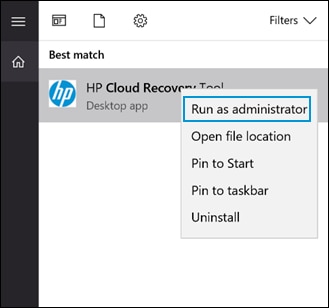
-
Carefully read the message on the HP Cloud Recovery Tool Welcome page, and then click Next to continue.

-
Proxy Configuration window:
-
If you are downloading the recovery software on a secure network, the tool automatically detects and populates the proxy information. Click Next.
NOTE:
If the proxy information does not automatically populate, check with your network administrator for the proxy information, and then enter it in the appropriate fields.
-
If you are downloading the recovery software on an unsecured network, skip to the next step.
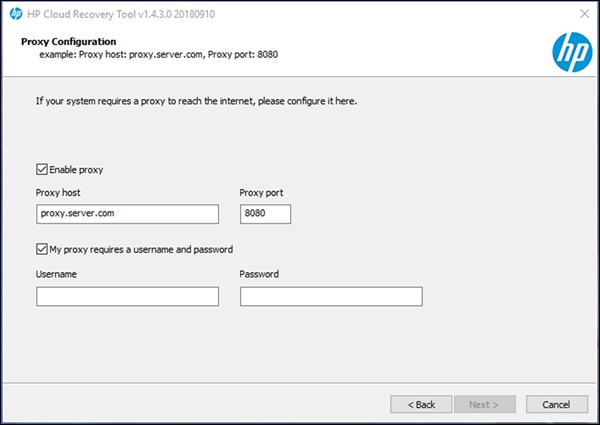
-
-
Complete the System Information.
-
If you are running the tool on the computer to be restored, when the HP Cloud Recovery Tool detects the system information for your device, click Next.
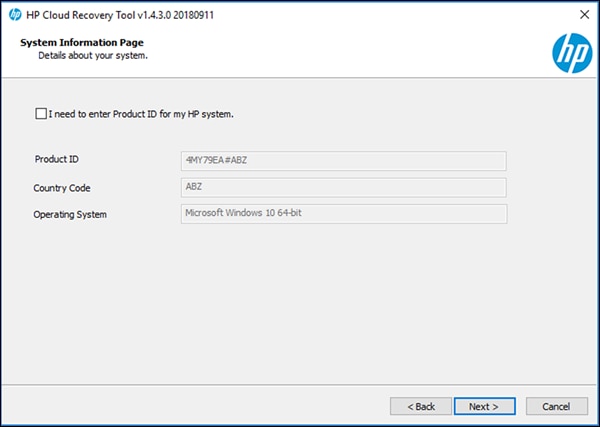
-
To manually enter the system information, check the box next to I need to enter Product ID for my HP System, enter the information for the computer to be restored, and then click Next.
NOTE:
If the Product ID has an ‘AV’ before the pound sign # and the three-digit number, do not include the #xxx (where ‘xxx’ represents a number). For example, a Product ID such as JGT75AV#123, you would not include #123. Doing so generates an error.
The Product ID might be located on the back cover of the PC. Otherwise, go to How Do I Find My Model Number or Product Number? (Desktop) or How Do I Find My Model Number or Product Number? (Notebook) for more information.

-
If the message Product ID is Not Match or Invalid. Check the "I need to enter Product ID for my HP system" and manually fill Product ID in. displays, your device is not yet available in the Cloud Recovery Tool. Go to HP Customer Support - Software and Driver Downloads for other available recovery options.
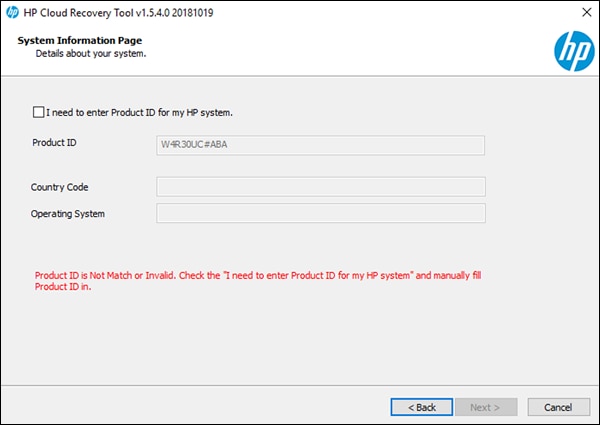
-
-
Select your USB device from the drop-down menu, and then click Next.
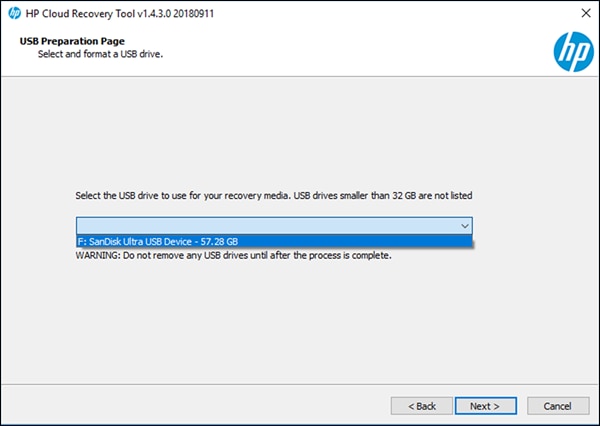
-
Carefully read the confirmation message informing you that any information on the USB drive is deleted during the process, and then click OK, Back, or Cancel.
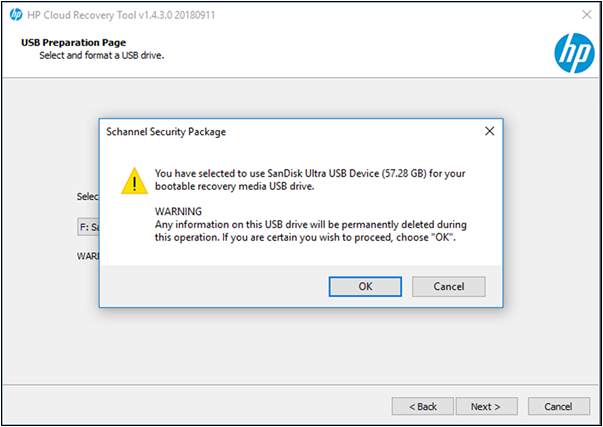
-
Click Next to continue.
-
Wait while HP Cloud Recovery Tool creates the Recovery Image on your USB drive.
A progress bar showing the preparation of the selected USB drive as an HP Recovery boot device displays. Click Cancel at any time to terminate the process and exit the utility.
NOTE:
This process might take several hours depending on the system configuration of your PC. Do not interrupt the progress by removing the drive(s) or rebooting the machine. If the process is interrupted, an error message displays.
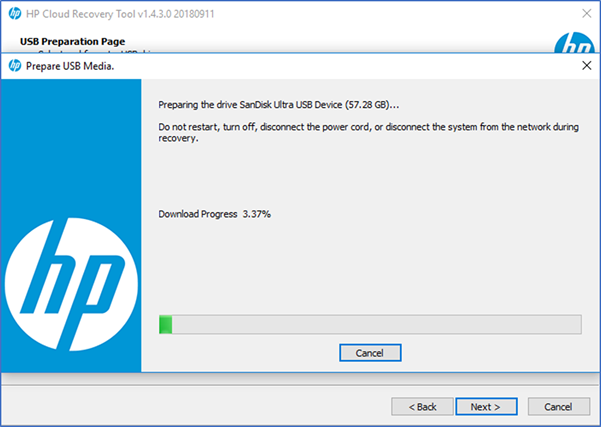
-
If the message The recovery USB Flash drive is ready. Do you want to delete the downloaded temporary files to save space in the drive? displays, click Accept to continue.
-
When the process completes, click Finish.
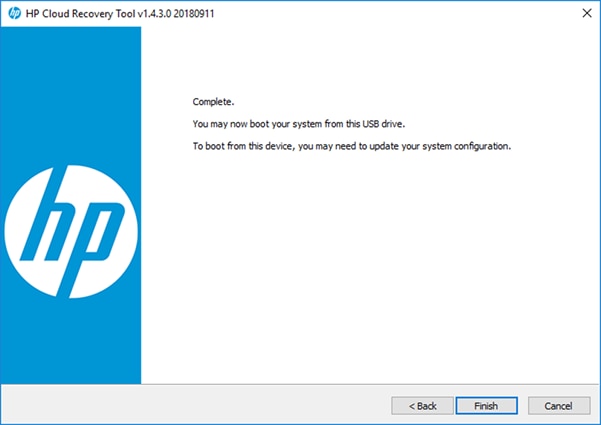
Step 4: Recover the system
Use the recovery boot device that you created using the HP Cloud Recovery Tool to recover your system.
-
Back up your personal files if you have not already done so. Go to HP PCs - Backing Up Your Files (Windows 10, 😎 or HP PCs - Backing Up Your Files (Windows 7) for more information.
-
Disconnect all connected devices and cables such as Personal Media Drivers, USB drivers, printers, or faxes.
-
Remove media from internal drives and remove any recently added internal hardware.
NOTE:
Keep the monitor, keyboard, mouse, and power cord connected to the computer.
-
Insert the USB boot device that you created, and then turn off the computer.
-
Turn on the computer, and then immediately press the Esc key repeatedly, about once every second, until the Startup Menu opens.
-
Press the F9 key to open Boot Device Options.
-
Use the up or down arrow keys to select the USB drive, and then press Enter.
NOTE:
More than one USB drive might be available from the list of devices. If so, select one of the USB drive options from the list to see if HP Recovery starts. If recovery does not start or a non-system disk error displays, restart the computer by pressing the power button, and then repeat these steps to select another USB drive. When recovery starts, continue with these steps to complete recovery.
If you cannot select the recovery media drive from the Boot Menu, disable Secure Boot and enable Legacy Mode in the BIOS.
-
When prompted to run Recovery Manager from the hard drive or from media, select Run program from media, and then click Next.
-
Select a language, and then click OK.
-
Select Factory Reset, and then click Next.
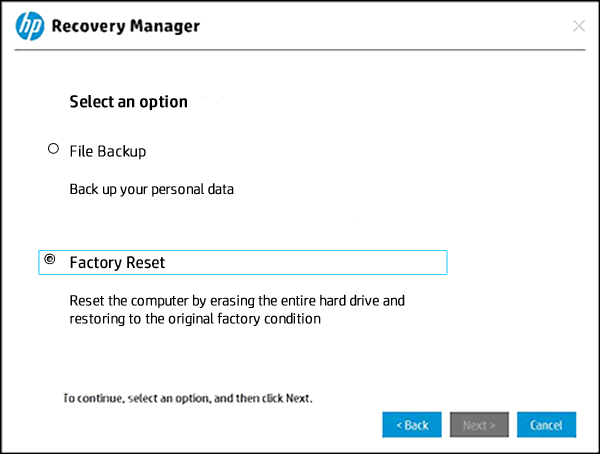
-
On the Welcome screen, click Next.
-
Select Recover without backing up your files, and then click Next.
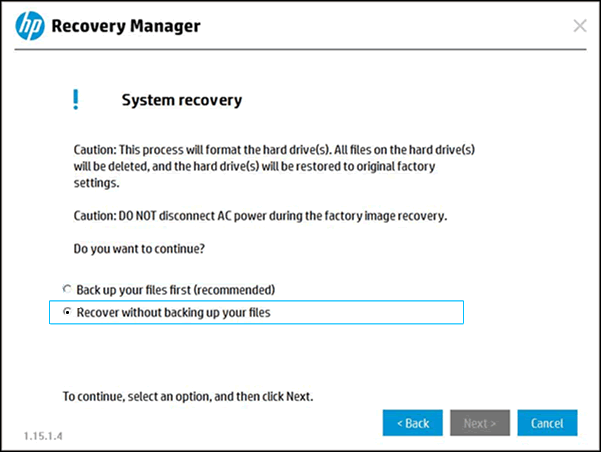
-
Wait while HP Recovery Manager prepares the computer for recovery and copies the files to the hard drive.
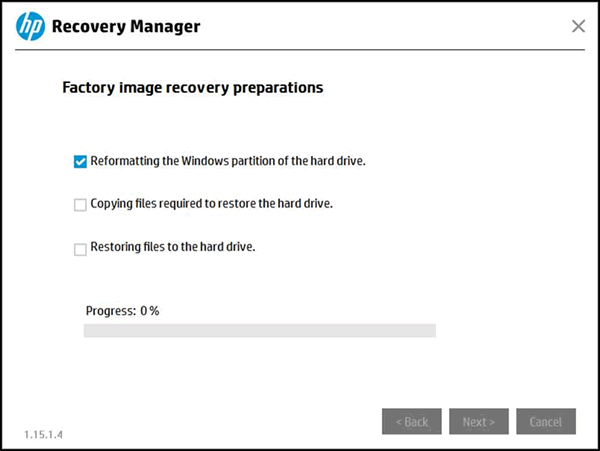
-
Click Skip when asked if you received a supplemental recovery USB drive from HP Support.
-
Click Continue when the recovery preparation completes.
CAUTION:
Do not stop the process while the Windows partition is being reformatted and the files to restore the hard drive are being copied.
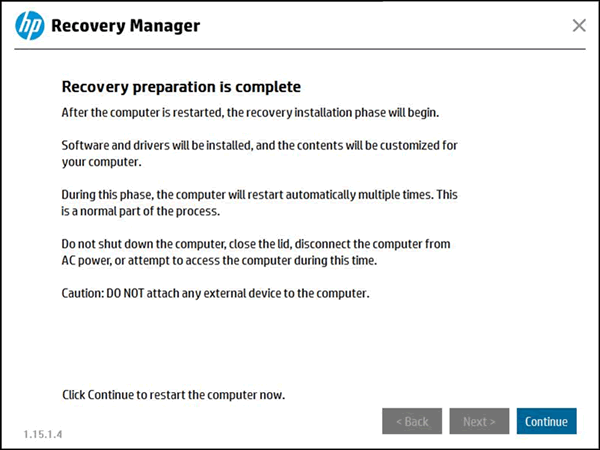
-
Do not remove the USB flash drive or turn off your computer during this process. The computer might go through several Software Installation screens, including black screens with the HP logo, Windows system screens, and Admin screens. This is normal.
NOTE:
The recovery process might take several hours to complete depending on the system configuration of your PC.
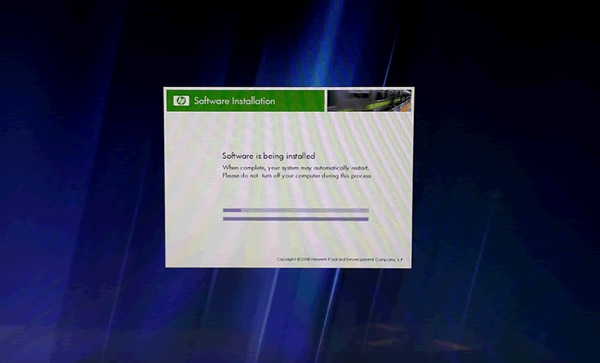
-
After the recovery completes, click Finish to restart the system.
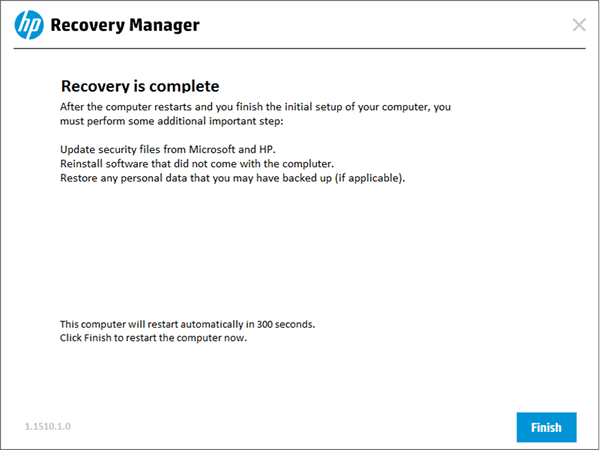
-
You can remove the USB flash drive after the PC initial setup begins.
Using the HP Cloud Recovery Tool (Windows 10) Link
